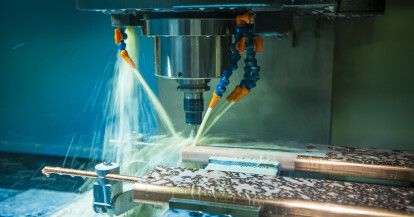Electroplating Guide - How It Works?

Industrial electroplating is a process that has been known for a very long time, but the demand for electroplated products is constantly growing. Many industries need it to meet the specific requirements of the components they produce and to offer their customers the highest possible quality.
Electroplating makes it possible to increase electrical conductivity, improve resistance to damage and extend the life of metal surfaces. One of these techniques is copper plating. What is it? What is it used for? And finally, what metals can copper plating be applied to?

What is the Electroplating Process?
Let's start with a definition of copper plating. It is a process in which other materials, usually metals, are coated with a layer of copper using the phenomenon of electrolysis.
The first and extremely important step in electroplating is to clean, degrease and etch the metal before the actual coating is applied. This removes all sorts of contaminants (such as rust and dust), fats and oils and metal oxides from the surface, which has a huge impact on the durability and quality of the coating.
The next step is to immerse the copper components in an electrolyte containing copper ions. Both the anode (the source of copper) and the cathode (the site of copper deposition) are connected to an electric current, resulting in a chemical reaction that causes copper to be deposited on the material.
The copper plating process can be carried out in different baths, selected according to the type of material to be treated. We distinguish between
- acid copper plating, which is the most popular and produces the most durable coatings, but has a limitation - it cannot be used directly on steel and iron components, which must first be pre-coppered in a cyanide bath;
- alkaline copper plating, which uses cyanide and cyanide-free baths - the former provides very good adhesion of copper to the substrate, but requires the use of toxic solutions, so phosphate-cyanide-free baths are more commonly used.
Metal plating using the copper plating technique is used worldwide as it has many advantages and can improve the properties and service life of many materials. Copper can also act as an intermediate layer, providing a good adhesion base for the next layer and improving the adhesion of other metals - e.g. silver, silver and gold, nickel, nickel and chromium or tin.
It is worth noting that copper plating is a form of cathodic electroplating, as the metal to be plated acts as the cathode, while the copper itself deposited on its surface acts as the anode.

What is the purpose of copper plating?
Copper plating has many applications. This process is used for several reasons:
- Firstly, electroplating a metal using copper allows it to be protected against nitriding and carburising. The coating formed as a result of copper plating protects the surface against the negative effects of heat, moisture and corrosion, as well as adverse weather conditions.
- Secondly, the electroplating of aluminium, steel, iron or zinc makes it possible to improve their electrical and thermal conductivity. Therefore, copper plating is used in the electrical industry.
- Thirdly, copper plating increases the resistance of metal surfaces to damage and also increases their durability. This is due, on the one hand, to the properties of the copper itself, which is characterised by high mechanical strength, and, on the other hand, to the very good adhesion of the layer produced to the substrate.
Additionally, electroplating services are provided not only for protective purposes but also for decorative ones. This is because the process of copper plating makes it possible to improve the aesthetics of metal elements, which is why it is often used in architecture, the decorative sector or the furniture industry.

Industries that use Electroplating
Given that copper is an excellent conductor of electricity and provides the electroplated parts with excellent conductivity, the process is particularly important in the electrical, energy and telecommunications industries.
Copper electroplating is also proving extremely useful in the automotive, construction, aerospace, chemical and even furniture industries, as it improves the strength parameters of many parts and products.
What are some examples of electroplating?
There are plenty of examples of copper electroplating, making it easy to see the significant impact this process has on various aspects of our lives.
- In the electrical industry it is used in the manufacture of connectors, printed circuit boards (PCBs), semiconductor components and much more.
- In the energy industry, it allows the protection of various types of components that are used to conduct electricity.
- In the construction industry, it is used to manufacture structural components such as railings, handrails and fences.
- In the automotive industry, it is used to produce corrosion-protected automotive parts, including body and individual system components, and even rims and door handles.
- In the furniture industry, it is often used to improve the appearance and durability of decorative elements or those used in gardens.
Examples of electroplating can be multiplied. Its use is extremely widespread and plays a very important role in modern industry.

Does electroplating prevent rust?
Yes, the layer of copper applied to the surface of a metal component during the galvanising process creates a protective layer, which protects against both corrosion and the negative effects of weathering. As a result, copper plating is ideal for the production of components exposed to moisture, changing temperatures and other harsh environmental conditions.
Can electroplating be done on any metal?
Copper electroplating can be performed on most metals - including precious metals.
Electris electroplating services
One of the technological processes that can be ordered from Electris is the application of electroplating coatings to copper and aluminium components. Among the most commonly used are nickel plating, tin plating, silver plating and copper plating. The appropriate coating is always selected based on the specific parameters of the components and their application.



